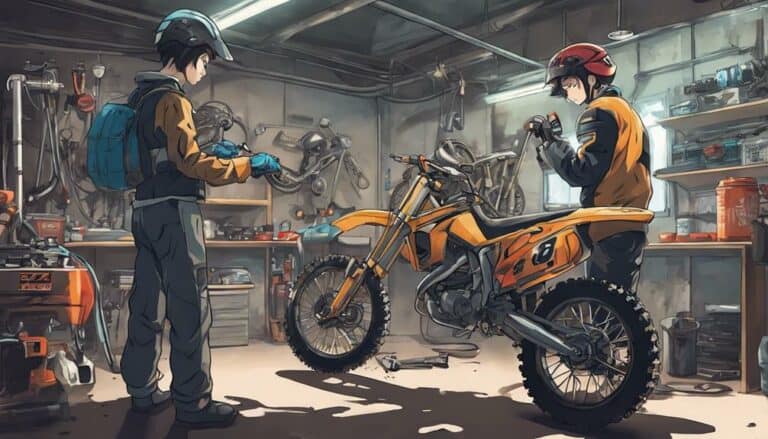Imagine your dirt bike's engine as a finely tuned orchestra, each part playing its unique role in harmony. Just like a conductor guarantees each instrument is in tune to prevent a cacophony, maintaining your dirt bike meticulously is essential to prevent a catastrophic breakdown.
From monitoring engine temperature to using high-quality fuel, there are key steps you can take to safeguard your ride. But what about those small yet significant details that could make all the difference in preventing a blow-up?
Key Takeaways
- Maintain air filter and valve clearances for optimal performance and reduced wear and tear.
- Monitor engine temperature and use quality coolant to prevent overheating.
- Use high-octane fuel and additives to safeguard against engine knocking and detonation.
- Follow manufacturer's guidelines for oil changes and care for air filter to prevent engine damage.
Importance of Regular Maintenance
Regular maintenance is the cornerstone of preventing dirt bike engines from exploding. Ensuring the air filter is clean and properly oiled is important to prevent dirt and debris from entering the engine, which can cause catastrophic damage.
Checking and adjusting valve clearances at recommended intervals, typically every 25 hours, is essential to maintain engine performance and prevent potential malfunctions that could lead to engine failure. Additionally, monitoring the water pump for any signs of leaks or malfunctions is necessary to prevent overheating, which can result in severe engine damage.
Neglecting these key maintenance tasks can lead to increased wear and tear on engine components, ultimately increasing the risk of engine failure. By staying diligent with air filter maintenance, water pump checks, and valve adjustments, you can reduce the chances of your dirt bike engine exploding during operation.
Monitoring Engine Temperature
To maintain peak engine performance and prevent catastrophic failures, closely monitor the temperature of your dirt bike engine to prevent overheating and potential damage.
When it comes to monitoring engine temperature, make sure to:
- Use a quality coolant: A good coolant helps maintain proper engine temperature and prevents overheating.
- Check for leaks: Regularly inspect the cooling system for any leaks that could lead to overheating and engine failure.
- Install a temperature gauge or warning light: Having a gauge or warning light will alert you to any sudden changes in engine temperature, allowing you to take immediate action.
- Avoid high RPMs: Prolonged high RPMs can cause the engine to overheat, so make sure to avoid pushing your dirt bike to its limits for extended periods.
Using High-Quality Fuel
Selecting high-quality fuel with an octane rating of 100 or higher is paramount in safeguarding your dirt bike engine from detonation and potential damage. Opting for fuels with higher octane ratings provides a higher level of resistance to engine knocking, allowing for better performance and protection.
Additionally, mixing race gas with pump gas can further enhance engine performance and longevity. Fuel additives like C12 or VP can be beneficial in boosting octane levels, ultimately improving engine efficiency. These additives not only enhance fuel quality but also play a critical role in safeguarding your engine from potential damage.
Checking and Changing Oil Regularly
Ensuring consistent maintenance by regularly checking and changing the oil in your dirt bike is essential for preventing engine damage and ensuring peak performance. Neglecting this essential aspect can lead to catastrophic consequences such as cam seizing, piston damage, and eventual engine failure.
To keep your dirt bike running smoothly, consider the following:
- Oil change frequency: Follow the manufacturer's guidelines for oil change intervals based on your riding conditions and the number of hours the bike has been in operation.
- Oil viscosity importance: Choose high-quality oil recommended by the manufacturer to ensure optimal performance and longevity of your engine.
- Signs of low oil levels: Check the oil levels before each ride and top up as needed to guarantee proper lubrication and prevent overheating.
- Manufacturer's recommendations: Adhere to the manufacturer's guidelines for oil changes to avoid potential issues and maintain the health of your dirt bike's engine.
Proper Air Filter Maintenance
Regularly inspecting and cleaning your dirt bike's air filter is essential for preventing dirt and debris from entering the engine. To guarantee peak performance, use filter cleaning techniques that involve gently tapping the filter to remove loose dirt and then washing it with a mild soap and water solution. After cleaning, thoroughly dry the filter before applying a generous amount of high-quality air filter oil to trap dirt particles while maximizing airflow.
Airflow optimization is key in maintaining engine efficiency, so make sure the air filter is properly oiled but not over-saturated. Additionally, regularly check the air filter for any signs of damage or wear, and replace it promptly if needed. Before every ride, especially in dusty or muddy conditions, inspect the air filter to prevent potential engine damage.
Conclusion
To keep your dirt bike from blowing up, always remember the importance of regular maintenance. Monitor engine temperature and use high-quality fuel. Check and change oil regularly, and ensure proper air filter maintenance.
Are you ready to take the necessary steps to guarantee the longevity and reliability of your bike?

